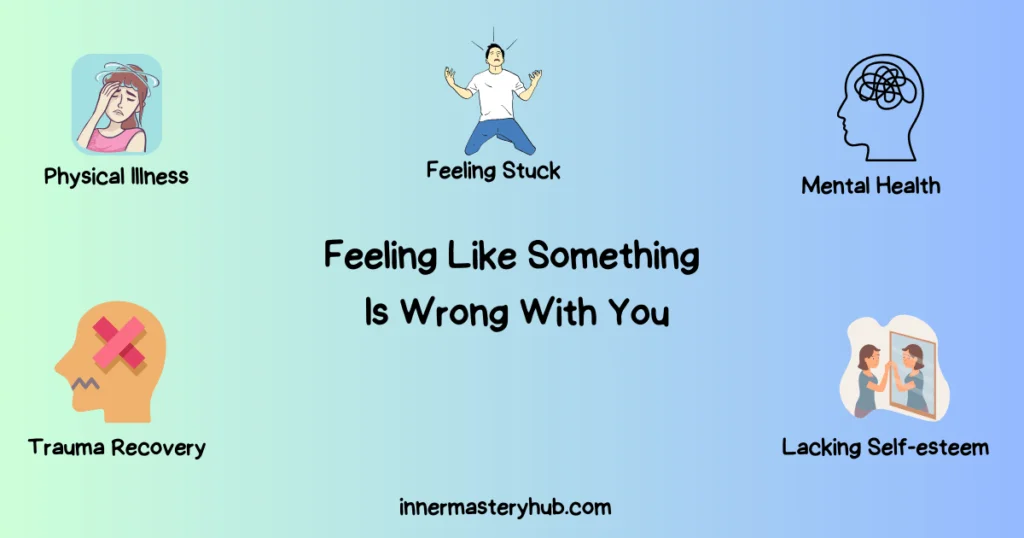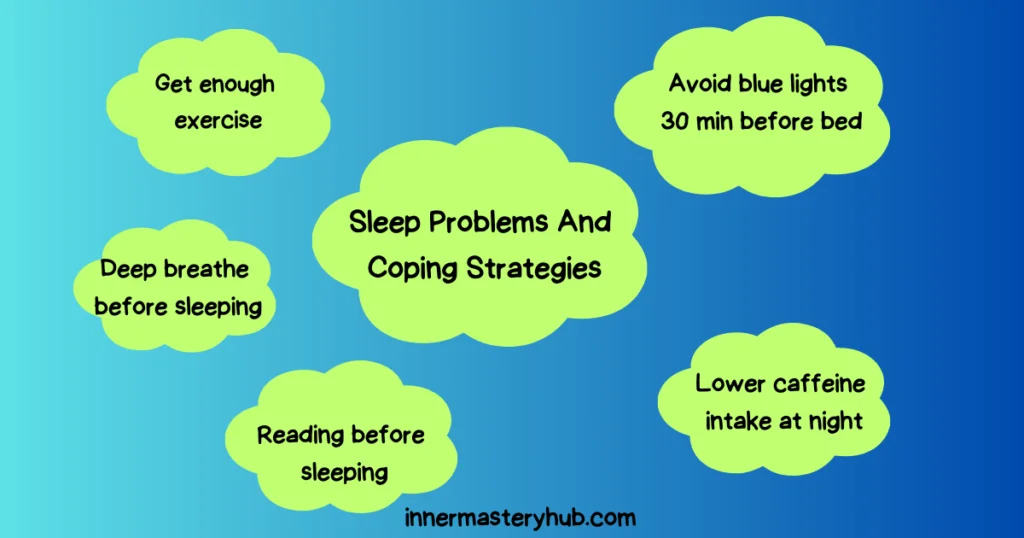
The question, “What’s wrong with me?” may arise for a variety of reasons. It may be a result of our anxiety, stress, or depression. A challenging period in our lives, such as a breakup, losing our job, or losing a loved one, could also be the cause.
This is a question we ask ourselves occasionally because we’re just overanalyzing the situation. We may be feeling inadequate by evaluating ourselves against others. Alternatively, we may be focusing on our regrets and mistakes.
“What’s wrong with me?” is a question that everyone asks oneself from time to time, regardless of the cause. It’s just a natural aspect of being human.
Remembering that self-doubt and questions like “What’s wrong with me?” are normal human emotions is crucial while you’re experiencing them. You can always attempt anything to feel better about yourself. Without passing judgment, make an effort to recognize and embrace your feelings. It’s acceptable to experience these emotions occasionally.
RELATED: 6 Ways to Live Life Without Regrets
Table of Contents
Common Reasons for Suffering, “what’s wrong with me”
You sense my problems because of suffering. Due to trauma or unfavorable childhood experiences, many people visit psychiatrists with this incorrect assumption.
This idea was sometimes assumed since we were abused as youngsters and didn’t meet our bodily or emotional requirements. We might have been deemed selfish for “asking for too much,” or told we couldn’t have what we wanted because we didn’t “earn it.”
We may misjudge ourselves as children if we are injured or abused. This can lead to self-abandonment, where we ignore our wants to satisfy others.
We may hide our emotions, especially forbidden ones like rage and despair. To be loved and accepted, we may people-please and be “good little boy or girl”.
All of this separates us from authenticity. We may spend our lives as others expect, but we’re never happy.
As a coping mechanism, some people acquire depression, eating disorders, addictions, anxiety, or sickness.
RELATED: Emotional Regulation: Skills, Exercises, And Amazing Strategies
Why You May Feel Like, “What’s wrong with me?”
We’ll start by assessing the causes, then explain ways to manage “What’s wrong with me?” There are many reasons you feel “what’s wrong with me,” from brief setbacks to long-term physical or mental issues. Check if any of these items resonate.
1. Thoughts Can Be Wrong
When we think “What’s wrong with me?” our thoughts can be inaccurate. Negative biases might make us believe false things about ourselves.
Here are some ways to relieve bad feelings when we feel off:
- “I’m not good enough.”
- “I’m a failure.”
- “No one loves me.”
- “I’m worthless.”
- “I’m a burden to others.”
These ideas are generally founded on past experiences yet may not be true. For instance, being teased as a child may make us feel inadequate. But this is simply an idea, not fact.
Remember that thoughts are not facts. We may think, “What’s wrong with me?” yet it’s not true. We can change our negative thinking and establish a more realistic and positive self-image.
2. Feeling Stuck
When you wonder, “What’s wrong with me?” you often feel stuck. Negative ideas and feelings may keep you stuck.
Some reasons we may feel stuck when we wonder what’s wrong:
- We may fear change. Even good change is scary. We may fear the unknown or losing what we have.
- We may need to adapt. If we wish to change, we may need a starting point. We may feel powerless.
- Negative or unsupportive people may surround us. People we spend time with affect our attitude and outlook. Negative or unsupportive people might make it hard to be positive about ourselves and our future.
These thoughts can be disturbing, but we will soon see how you can cope.
3. Change What Needs To Be Changed In Yourself
Change can empower and challenge. We’re taking charge and improving our lives, which is empowering. This boosts self-esteem because we regard ourselves as transformable. It’s difficult because change is rarely easy. It requires breaking old routines, leaving our comfort zones, and facing internal and external barriers.
4. Mental health issues
Mental health concerns may be draining, with walls whispering self-doubt at every turn. It’s amazing how anxiety can change your self-image. Like a constant voice telling you you’re too anxious, worried, or too much. You may feel like something is wrong with you.
Anxiety, sadness, or other mental issues can make us feel weak, damaged, or inadequate. We may utilize our perceived flaws to establish our worthlessness.
5. Experiencing Physical Illness
Our self-image can be greatly affected by physical sickness. My life changed when I was diagnosed with a chronic condition. Suddenly, my body seemed foreign. The symptoms, drugs, and limitations kept reminding me, “What’s wrong with me?” It seemed like my body betrayed me and eroded my self-esteem.
One of the biggest ways physical sickness affects self-image is by changing self-perception. Our disease may make us see our limitations and discomfort. This can make us feel less capable, attractive, or different from our pre-illness selves.
6. Feeling Overwhelmed
Having that overwhelming sense while thinking something is wrong is hard. An example from real life:
Imagine juggling a job, family, and personal ambitions as a wave of tremendous stress hits you. You may feel unprepared for even the simplest chores. You feel inadequate and imperfect, convinced that you’re not as capable as others. Your self-doubt seems to be constantly brewing, making it hard to find serenity in the tumult.
7. Lacking Self-esteem
You constantly doubt your ability and feel unworthy of praise. You may be at a party but distracted with ideas of others judging you.
Many reasons can lower self-esteem, including:
- Negative childhood experiences
- Criticism from others
- Bullying
- Perfectionism
- Unrealistic expectations
- Mental health conditions, such as depression and anxiety
8. Personal Relationship Issues
Personal connection troubles can increase your insecurities if you’re already feeling off. Imagine continually second-guessing your behavior and comments around friends and family. You can think they’re silently judging you, disliking you, or you’re not good enough to keep these relationships.
Self-doubt may cause you to avoid social events and share your thoughts and feelings, distancing you from loved ones.
Rejection, unhappiness, worry, and self-criticism can result from personal connection troubles. Recognizing that these sentiments may represent your problems rather than reality is crucial.
9. Experiencing Trauma
Imagine a severe occurrence like an accident or a devastating loss. Recurring nightmares, persistent thoughts about the event, or overpowering anxiety may develop over time.
These encounters can make you question your sanity and believe you’re flawed. You feel like you’re in a maze, fighting symptoms that make you feel out of control.
Understanding that these symptoms do not define you is crucial. These are common trauma responses and cognitive processing.
10. Problems at Work
Imagine yourself at work, struggling with self-doubt, worry, and a deep sense of inferiority. You may struggle to focus because you worry that your coworkers are evaluating you or discussing your shortcomings. These feelings might make your workplace a self-criticism battlefield where each day is a test of self-worth.
Thus, workplace issues can have serious consequences. Stress can cause sleepless nights and negative self-talk. This can damage your well-being and personal life, straining connections and isolating you.
How to Cope: 11 Ways to Feel Better
Whatever the cause of the feeling that something is not right with you, there are steps you may take to reduce it. The specific cause will determine the coping strategy you apply.
1. Practice Self Care
Taking care of your physical, mental, and emotional wellbeing is self-care. You must practice self-care to be your best and live a satisfying life.
Self-care takes various forms. Here are some ideas:
Take care of your health by getting enough sleep, eating appropriately, and exercising regularly.
Establish clear boundaries to safeguard your time and energy. Say no to overwhelming responsibilities and yes to self-care.
Schedule time for hobbies and activities that offer you delight. Painting, playing an instrument, or trekking can refresh you.
Prioritize self-reflection by regularly evaluating goals, values, and aspirations. Self-reflection helps you make real choices.
Disconnect: Taking pauses from screens and technology is crucial in the digital age. A break from technology can reduce stress and improve attention.
2. Coping With Anxiety
How to cope with anxiety, here are some tips:
- Deep breathing exercises can soothe your nervous system.
- Exercise regularly to reduce stress.
- Maintain a balanced diet and limit caffeine and sugar.
- Get enough sleep for mental and emotional health.
- Notice your erroneous thoughts and replace them with rational ones.
- Set achievable goals and break them down.
- Establish a daily schedule for predictability.
- Consider anxiety-reducing vitamins or drugs if advised.
3. Coping With Depression
Depression is a treatable condition, and time and support make recovery possible. Here are some steps on how to cope with feelings of depression:
- Maintain adequate hygiene and self-care.
- Record emotions, triggers, and progress in a journal.
- Consult a therapist or psychiatrist.
- Build family and friend support.
- Exercise regularly to increase mood and vitality.
- Get enough sleep and stick to it.
- Minimize alcohol and recreational drug use.
- Relax with deep breathing and increasing muscle relaxation.
4. Schedule a Time to Worry
By scheduling time to worry, cognitive behavioral therapy (CBT) can help you stop worrying about situations beyond your control. You worry about whatever you’re worried about occasionally instead of all day.
Follow these steps to plan worry time:
- Choose a time and place where you will not be interrupted.
- Set a timer for 15-30 minutes.
- During your worry time, write down all of the things that you are worried about.
- Once the timer goes off, stop worrying and continue your day.
5. Observe Your Body
Body observation is nonjudgmental attention to physical sensations. It can improve bodily awareness, stress management, and health detection.
How to proceed:
Be there. Focus on your body and sensations.
Maintain consistency. Daily, monitor your body for a few minutes.
Once comfortable, scan your body from head to toe while practicing breath awareness. Feel every aspect of your body. This could be heat, cold, tension, relaxation, discomfort, or anything else.
Brain fog. To declutter, write everything on a to-do list or action plan.
Restless.If you can’t sit still, stroll or do yoga, high-intensity interval training, or treadmill walking.
Tensed/uneasy. Deep breathing, meditation, and PMR are advised.
6. Make an Action Plan
Here’s a concise action plan for coming out of a negative mindset or circumstances:
- Define achievable goals.
- Break goals into achievable steps.
- Try problem-solving.
- Inspiration comes from success stories.
- Strengthen familial, friend, and romantic relationships.
- Develop hobbies like knitting, sports, or exercise to release endorphins and boost self-esteem.
- Read self-help books on your interests.
- Having a partner who holds you accountable helps you progress.
7. Gain a Fresh Perspective
Determine achievable goals.
Divide ambitions into manageable steps.
Try problem-solving.
Success tales inspire.
Improve family, friends, and romantic connections.
Take up knitting, sports, or exercise to release endorphins and increase self-esteem.
Read interest-related self-help books.
A companion who holds you accountable helps you grow.
8. Accept Happiness
Accepting sadness shapes our emotional surroundings. We often assume we’ll always be happy, yet life has ups and downs. Understand that sadness is a normal human feeling, not a flaw or weakness.
Instead of self-criticism, be kind. In those times, be kind to yourself. Unhappiness often reveals the truth or suggests change. Accept it, discover its origin, and get help when needed. By understanding misery as fleeting, you can build resilience and better handle life’s inevitable challenges.
9. Relaxation Techniques
Relaxation techniques are:
- Valuable tools for reducing stress.
- Promoting a sense of calm.
- Improving your mental health.
Here are some relaxation techniques to try:
Deep breathing. Carefully inhale through your nose for four, hold for four, then slowly expel through your mouth. Repeat often.
Progressive Muscle Relaxation: Tend and relax each muscle group from bottom to top. This reduces physical strain.
Be mindful or meditate. Sit or lie down in a quiet place and focus on breathing, a word, or a soothing image. Focus on the now and ignore your rushing thoughts.
Visualization. Imagine a peaceful place with your eyes closed. Imagine a serene setting to reduce stress and anxiety.
Nature Walks. Outdoors may be calming. Clear your head by walking in a park or on the beach.
Journaling. Write down your ideas and feelings to relieve tension and substitute treatment.
Use essential oils like lavender, chamomile, or eucalyptus for aromatherapy to create a relaxing ambiance.
Nature Walks. Being in nature is relaxing. Clear your head by walking in a park or on the beach.
10. Change that needs to be changed
Changing one aspect of yourself is a personal journey that requires introspection and determination. It begins with identifying the specific trait, habit, or behavior you wish to transform and understanding the underlying reasons for this desire.
Once you have a clear goal, it’s essential to break down the change into manageable steps and set a realistic timeline for achieving it. Seeking support from friends, family, or a mentor can provide valuable encouragement and hold you accountable.
Educating yourself about the change you want to make is crucial. This knowledge equips you with the tools and insights needed for successful transformation. Be patient with yourself during this process, as change often takes time and persistence.
11. Spend Time With Your Loved Ones
It’s priceless and fulfilling; spending time with family fosters closeness. Family, friends, and romantic encounters shape our lives. Meaningful talks foster support, joy, and memory-sharing.
These interactions can bring comfort in hard times and joy in joyous ones. These encounters’ warmth and intimacy can also provide consolation and a sense of belonging in a chaotic world. Spending time with loved ones shows how much we value these relationships and reminds us to appreciate them.
Final Thoughts
If you’re struggling to admit an issue, starting change can be difficult. Understanding the causes of these feelings is crucial. Consult a doctor for physical conditions. Mental health issues need equal attention. Life stressors may require a plan to reduce stress and improve life. Talk to a therapist.
If the cause is unclear, introspection is needed. Think about trends and viewpoints. Learn to alter your thinking to achieve goals.
When these procedures fail, help is needed. Many others feel this way, and support is available. Volunteers with training can help you find solutions and an exit from “What’s wrong with me?”






